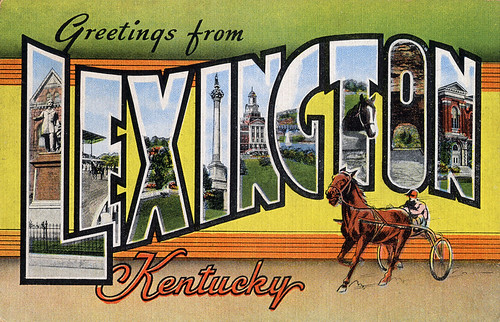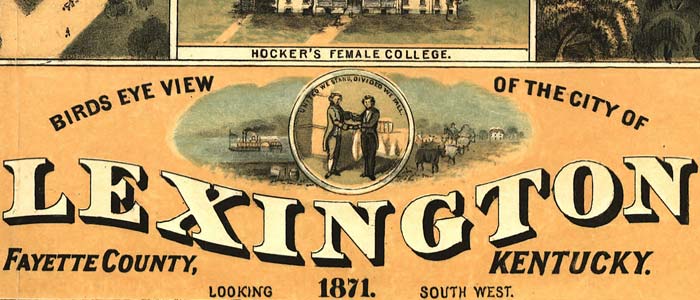
On 1 February 2012, Lexington Herald-Leader's columnist, Tom Eblen wrote: "Without the Civil War, who knows when Lexington's slave trade might have ended?" -- A century and a half ago, the Civil War began to reach Kentucky and bring an end to one of Lexington's most thriving businesses: the sale of people.
Slave labor built the prosperous hemp and tobacco plantations and stock farms of the antebellum Bluegrass. Whites also owned black slaves to cook their food, clean their homes and care for their children.
As Black History Month begins, it is worth noting that from the 1820s until the Civil War, Lexington was one of America's largest slave markets. Geography, demography and economics "put Lexington right in the center of this activity," said Gerald Smith, a University of Kentucky history professor.

By the 1820s, Virginia, Maryland and Central Kentucky had a surplus of slaves just as the Deep South's expanding cotton, rice and sugar plantations needed more labor. Much of that surplus ended up in Lexington to literally be "sold down the river." Listen to the words of the state song, My Old Kentucky Home; that is their story.
When the Civil War began, Lexington had more than 10,000 slaves — almost half the total population — and about 1,700 slave owners. Still, many slave owners looked down on slave traders as cruel beasts — perhaps not wanting to acknowledge the full picture of their own "peculiar institution."

Some sales were conducted privately at the several slave jails along Short Street. The largest of those jails were Megowan's at Short Street and Limestone, Pullum's on Broadway just north of Short, and Robards' on Short between Broadway and Bruce Street.
But many slaves were sold at public auction at Cheapside. The auction block was on the southwest corner of the Fayette County courthouse. On the northeast corner was the slave whipping post — a locust log 10 feet tall and a foot in diameter. It was installed in 1826, and when it wore out in the 1840s, it was replaced by a nearby poplar tree.
"It was an embarrassment for many Lexingtonians to have this slave trading going on downtown," Smith said. "It didn't conform with the cosmopolitan image they wanted to cultivate."

Cheapside Slave Auction Block, Lexington, Kentucky
When future President Abraham Lincoln visited his wife's family in Lexington for three weeks in the fall of 1847, five slaves were sold at Cheapside to settle a judgment that her father, Robert Todd, had won against their owner, John F. Leavy, according to William Townsend's book, Lincoln and the Bluegrass.
Several controversial laws tried to prohibit traders from bringing slaves to Kentucky from other states to be sold. An 1833 law, one of the toughest of any slave state was widely ignored. But after a pro-slavery state constitution was adopted in 1849, Kentucky's slave trade flourished. More than 15 percent of Kentucky slaves were sold south from 1850 to 1860.
Smith said that, more than any slave-trading city except New Orleans, Lexington was known for its "fancy girls" — light-skinned, mixed-race young women who were sold into sexual slavery. The best-known dealer was Lewis Robards, who kept his "choice stock" in parlors above his Short Street office.
Not all of these deals were conducted behind closed doors. The most infamous case involved a beautiful young woman named Eliza — said to be just 1⁄64 black — who was sold at Cheapside in May 1843 to satisfy the debts of her deceased master and father.
Abolitionist accounts of the sale tell of a hard-hearted auctioneer who exposed Eliza's breasts and thighs to encourage bidders, much to the horror of the assembled crowd. The bidding came down to a Frenchman and the Rev. Calvin Fairbanks, who had come to Lexington for the purpose of buying Eliza and setting her free. Fairbanks won with a bid of $1,485.
Without the Civil War, who knows when Lexington's trade in black men, women and children might have ended? Most whites 150 years ago were content to look the other way — unless slavery's victims looked too much like them.
"Several of these fancy girls, if you didn't know any better, you would have thought they were white," Smith said, adding that Eliza's story added steam to the abolitionist movement. "It was as though a white woman was on display, and people were not going to stand for that." -- By Tom Eblen (source Lexington Herald-Ledger)
Lexington, Kentucky: "Cheapside" -- During the dark era of slavery in Kentucky, the section of town in Lexington known as "cheapside" became the largest slave-trading locality in the state. In fact, the area was one of the most well known of the slave market districts in the South. Africans were beaten and families were separated forever as they were auctioned and sold in the courtyard. According to historical narratives, President Abraham Lincoln once observed the selling of slaves at this site. In the post-war period, "cheapside" served as a public square and a market. This photograph shows a court day in November 1887.
(source:http://www.visitlex.com/afamheritage-trail/03Cheapside.php )






Thanks for your good Post
ReplyDeletehttp://www.livestreamsportshd.com/
Thanks for your good Post
ReplyDeletehttp://www.livestreamsportshd.com/
If you think this just another one of those articles.
ReplyDeleteLong tail searches are combined searches formed from several high frequency keywords and key phrases.
(I can see that the light-bulb has finally come
on.
Here is my website - sem
Good post. I learn something totally new and challenging on blogs I stumbleupon every day.
ReplyDeleteIt's always interesting to read articles from other writers and practice a little something from other web sites.
Stop by my homepage: houston dental implants
For the reason that the admin of this site is working, no doubt very quickly it will be well-known, due
ReplyDeleteto its feature contents.
my web page - fastest way to lose Weight
It's a shame you don't have a donate button! I'd definitely donate to this excellent blog! I guess for now i'll settle for bookmarking and adding your RSS feed to my Google account.
ReplyDeleteI look forward to brand new updates and will share this blog with my Facebook group.
Chat soon!
Check out my web page :: teeth whitening gel